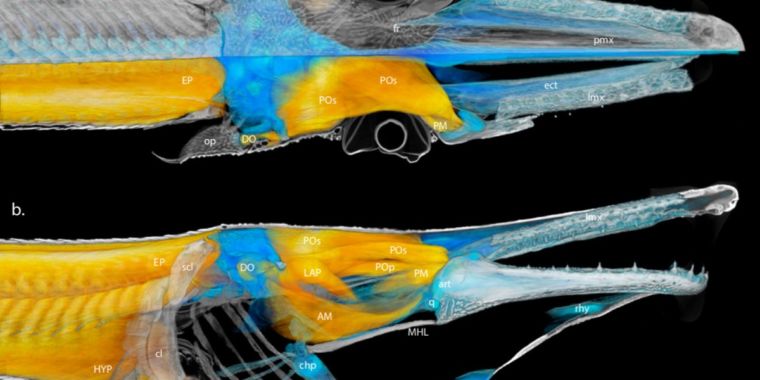
Scientists had assumed the alligator gar catches its prey simply by slamming its powerful, tooth-y jaws shut. But according to a new study posted to the pre-print site bioRxiv, the fish also creates a fast, powerful suction force to suck prey into its jaws by moving the bones in its skull and shoulder. The paper is currently undergoing peer review for the Journal of Morphology.
Alligator gar are the largest species in the gar family of freshwater fish, and they can grow as large as 10 feet and 300 pounds. They are often dubbed “living fossils” because their earliest ancestors in the fossil record date back over one hundred million years to the Early Cretaceous period. Once considered a “trash fish,” they are primarily found in the southern US (Arkansas, Louisiana, Texas) along the Gulf of Mexico.
They get their colloquial name from the fact that they share a broad snout and long teeth with the American alligator—most other gar have long slender snouts. Because of this, it was assumed that the alligator gar used a similar lateral snap of the jaw for feeding, but according to lead author Justin Lemberg of the University of Chicago, the jaws of the alligator gar have a lot more joints, and hence greater mobility, than their reptile namesakes.
“I was interested in how those joints were capable of moving during the feeding process, and what might be the reason for those jaws being able to move,” Lemberg said of his decision to study this unusual fish species. The US Fish and Wildlife Services in Warm Springs, Georgia, donated several baby alligator gar from a batch they’d been breeding for eventual reintroduction to the wild—basically the runts of the litter. Lemberg drove from Georgia to Chicago with the gar sloshing around in the back seat of his Honda Civic.
-
Baby alligator gar feeding the lab.J. Lemberg et al.
-
Reconstructed gape cycle and feeding kinematics of Atractosteus spatula, aka the alligator gar.J. Lemberg et al.
-
Components of the mechanism of cranial kinesis of Atractosteus spatula. 1213 Reconstructed cranial anatomy based on contrasted-enhanced CT scans.J. Lemberg et al.
-
Fully expanded feeding apparatus detailing the hyoid constrictor sheath and underlying skeletal elements.J. Lemberg et al.
-
Fully expanded feeding apparatus detailing axial musculature and constrictors of the mandibular arch.J. Lemberg et al.
Once back at the lab, he and his colleagues recorded the young gar feeding on freeze-dried krill using a high-speed camera to capture the biomechanics of their jaws. Then they CT scanned a gar fish head to develop a high-resolution 3D model of its skull. Lemberg used that model to help build a better visualization of how the jaw bones moved during feeding. “I’m a very visual learner, so I loved making a lot of the models and figures and animations,” said Lemberg.
The alligator gar’s double row of teeth along the upper jaw are well-suited to preying on smaller fish water fowl, frogs, small mammals, and the occasional bit of fishing tackle by mistake. “Anything they can capture and swallow safely, they will eat,” said Lemberg. Alligator gar typically float below the water’s surface waiting for something tasty to swim by, then lunge forward rapidly with a lateral strike to impale their prey. Feeding strikes occur over just 42 milliseconds (less than a tenth of a half a second).
However, as physicist Nicole Sharp explains over at FYFD:
“Hydrodynamically speaking, that’s a tough way to catch dinner. As soon as the gar’s snout accelerates toward its prey, it pushes a bow wave ahead of it, like an early warning signal. To counter that disadvantage, the gar has a complex bone structure in its skull that helps it generate suction. Each expansion sucks in water, and by timing them just right, the gar produces suction throughout its entire attack. The bow wave warning does its prey no good if both are already getting sucked into the gar’s mouth.”
Fish in general have pretty mobile skulls, according to Lemberg—a characteristic known as cranial kinesis. This allows them to move their upper and lower jaws, as well as their gills and gill covers. Specifically, the palate moves relative to the brain case, pushing outward to expand the skull and draw water in. That movement is controlled by a small bone called the hyomandibular (the same bone as the human stapes in the inner ear). Because alligator gars have a very shallow palate, it was assumed they couldn’t rotate them very much. Any upward rotation would simply knock against the skull rather than expanding it.
But Lemberg et al. discovered that isn’t the case. Rather, the alligator gar’s jaw moves sideways to expand the skull. “We show that they are able to rotate [their palates], it’s just in a different plane than what people were expecting,” said Lemberg. “They’re able to slide their palates laterally outwards as they chomp down on their prey, and they have specialized overlapping joints that come apart.”
The next step is to take what they’ve learned about the biomechanics of feeding of modern alligator gars and apply that knowledge to the fossil record. That said, “Gars are really useful for the ancestral traits they preserve, but they’re also really interesting in their own right,” said Lemberg.
Listing image by Lemberg, J. et al.
https://arstechnica.com/?p=1482383

